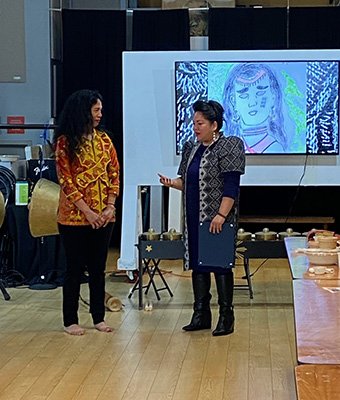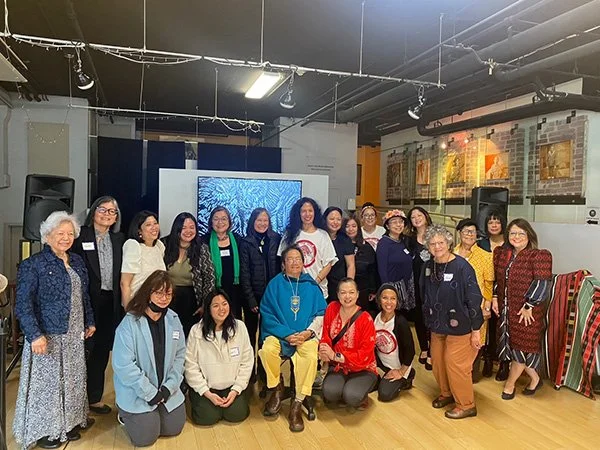But Where Are the Manangs?
/(L-R) Q&A facilitator Lorna Dietz, co-producer Esperanza Catubig, co-producer & editor Jessica Sison, executive producer & director Caroline Cabading, and Jeanette Lazam
“The Manangs, Filipina women elders, have long served as pillars of strength and wisdom in our community. They’ve nurtured families, fought for justice, and preserved our cultural heritage. But their voices are often underrepresented, their stories untold.”
Caroline Ocampo and I hosted this special event for 25 women at the International Hotel Manilatown Center in San Francisco, California. As the women entered the “sacred space,” they were greeted by six members of the Manilatown Ancestral Ensemble, playing instruments of the Kalinga Bamboo Ensemble. A short cultural performance followed, featuring Tausug music and the Pangalay dance from Southern Philippines.
(L-R) Lola Weavers advocate Ann Reginio with event hosts, Caroline Ocampo and the author
“If you are visiting Manilatown for the first time, welcome home! If this is not your first time here, then welcome back home!” Caroline Cabading, MHF’s executive director, greeted everyone once the guests were seated,
Cabading showed the group a sample of a long weave, a tapestry that depicts the connection of sister weavers from Kalinga of the Cordillera mountains in Northern Philippines and International Hotel Manilatown Center. The tapestry is an example of Kalinga backstrap weaving.
Executive Director Caroline Cabading explains the Kalinga people’s distinctive backstrapping weaving techniques.
After Daly City Mayor Juslyn Manalo presented a certificate of recognition, the women took part in a crash course on the significant contributions of Manilatown. According to MHF, “The International Hotel was a low-income residential hotel that became the most dramatic housing-rights battleground in San Francisco history. The I-Hotel stood on the last remaining block of Manilatown, a once-thriving Filipino neighborhood that was gradually displaced by San Francisco’s expanding financial district.”
Daly City’s Mayor Juslyn Manalo presents Manilatown Heritage Foundation with a Certificate of Recognition.
“On August 4, 1977,” according to Cabading, “we lost the last remnant of historic Manilatown with the eviction of tenants from the I-Hotel. The scene at that time was a human chain of 3,000 people trying to defend this home. We lost that battle, the building was demolished, and it stayed a pit for many years. Nearly 25 years later, in 2005, we were able to rebuild what the I-Hotel was meant to be, which is low-income housing for elders.”
At the screening of Manilatown Manang, the audience met Jeanette Gandionco Lazam, a Manilatown Manang, one of the young human rights tenant-activists who had lived at the I-Hotel. On that historic day, August 4, 1977, among the last tenants who were forcibly removed were Wahat Tampao, a Benguet-born I-Hotel tenant and elder leader, and Lazam. The then 23-year-old activist was the last evicted tenant to claim residency at the new International Hotel Senior Residences on June 3, 2021.
The 45-minute film takes the viewers on Lazam’s journey from her childhood to today. Along the way, she shares many stories, including the Manongs and Manangs who became her pseudo-parents during her I-Hotel tenancy. The documentary clearly answers the question, “But where are the Manangs?”
Cabading explained: “This film proves that two generations of Manangs of the I-Hotel were working side by side with their male comrades, defending the I-Hotel. Today, a third and fourth generation of Manilatown Manangs are telling these women’s stories.”
As executive producer, Cabading disclosed that Manilatown Manang is the first film she directed. She introduced her team: Esperanza Catubig, co-producer, and Jessica Sison, co-producer and editor.
Denise Miles proudly whispered to Caroline Ocampo, “That mural was my idea. Wells Fargo sponsored that!” referring to one scene, the unveiling of a new mural at the Chinese Culture Center, which featured 12 important but often unrecognized Asian American and Pacific Islander community leaders. Lazam and Cabading were two of the acknowledged AAPI heroes.
Author Liza Gino asked the producers, “What can we do to support this film?”
Candid responses from the production team ranged from finding a venue that has a large screen and can seat 300 people to sharing the website link for donations with everyone’s network of friends.
Cabading said, “We are at an interesting crossroads because we are blessed to get $20,000 as seed money many years ago to start. The film already costs twice as much. We’ve been trying to get film grants. The feedback that I get whenever I show this to community -- they feel it, they’re crying ‘This is appropriate. These are the stories we need to hear; these are the stories of us.’”
She continued: “Filmmakers in the mainstream industry say, ‘It’s a great oral history but it’s not good enough for film festivals.’”
Jessica Sison disagreed, saying, “There are many Filipino film festivals in the US. You can do community screenings. Believe in your film! Believe in your skills!”
“Cabading explained: ‘This film proves that two generations of Manangs of the I-Hotel were working side by side with their male comrades, defending the I-Hotel.’”
Patti Chang, a longtime friend of Lazam, commented, “This story, this filmmaking, the quality is amazing. I’m not Filipino. This story is not just about Filipinos. It is a story about movements, the story of the women’s movements, the story of the human rights movements -- and I think there are audiences that would love to see this because there is a gap in our collective history. My question is, because I am also a fundraiser, is ‘How much money do you need?’”
As the discussion continued, Lazam acknowledged one guest, encouraging the audience not to break the continuity in sharing stories about the Manangs. “People will not know that Cynthia Bonta was instrumental in forming the United Farm Workers. She was there!”
Housing rights advocate Teresa Dulalas and her daughter Marti Dulalas shifted the conversation to the importance of today’s children all over the US knowing more about the history of the Manongs and Manangs.
Educator/Community Organizer and Lola Weavers’ advocate Ann Reginio piped in with, “There are many Filipino American communities. Why do we only have five schools catering to these young kids? I feel like taking on this movement and bringing it to the next generation. You have all been doing your part. And it’s for us to keep on continuing that vision, empowering them, recognizing all the Manangs that came before us, our Modern Manangs.”
A group photo after the event
Silicon Valley entrepreneur Christina Laskowski revealed she is the mother of two boys searching for a local school that can teach them Tagalog. She also stressed the importance of investing in people and developing products and services “in-country.”
Lazam closed the discussion, saying, “I am an American and I have every right to be here as much as anybody else. And we have to support that right for all people. That’s why the anti-racist movement is very important for people to understand and interact in any way you can. It’s not always through speeches. Sometimes, it is through the ballot. We are Americans and we have every right to be here.”
The program was capped by networking and shopping at the Lola Weavers pop-up shop, which was especially curated for the women’s event. The selection of weaves came directly from the elders of the Tinguian tribe in the province of Abra, Northern Philippines.
It was, indeed, a special day for the Modern Manangs.
The International Hotel Manilatown Center is a gathering space and museum for everyone to remember and guide the legacy of Manilatown, a 10-block neighborhood that once existed, which the Filipino community lost, its legacy forgotten in the dust and rubble of gentrification. Today, MHF organizes family-friendly programs, many of them free. Its focus on arts and culture, music and dance, and weaving, birthed a “community of practice,” people who dive deeply into any of MHF’s programs, working with culture bearers so “they can stay honest.” See https://manilatown.org/.
Lorna Lardizabal Dietz is a Filipino community publicist and a cultural empowerment advocate. She is a member of the board of directors of the San Francisco Filipino Cultural Center.
More articles by Lorna Lardizabal Dietz








